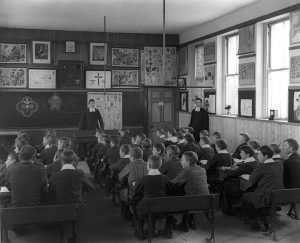LEARNING SPACES
One of the more recent developments in education at all levels, from primary to post-secondary, is the movement towards creating distinct and flexible active learning environments that engage students in nontraditional ways.
STEM (Science. Technology. Engineering. Math.) learning or STEAM (Science. Technology. Engineering. Arts. Math.) learning, has placed greater emphasis on the application of disciplines through hands-on tinkering and experimentation of materials. The rise of 3D printers and robotics labs in schools have enabled students to visualize concepts both digitally and physically while making real-world connections. A popular name for one form of this “doing” environment is MakerSpace.
At its heart, the term maker space is about collaboration. That is, bringing people and ideas of diverse backgrounds and disciplines together to generate ideas and solve problems. Having spaces that facilitate those goals is critical, especially in the modern learning environment, whether for young students in a K-12 setting or college students in a higher education setting. (Schafer, D. & Yamasaki, K. 2017)
https://crej.com/news/designing-creative-collaboration-school-spaces/
But here’s the thing. Since the 1970’s, educators have been trying to reimagine classroom space to accommodate early childhood developmental and pedagogical research. Many schools at that time tore down their walls in an attempt to foster collaboration between students and teachers. Unfortunately, human psychology reared its unconscious head and very soon those same free spaces of learning became noisy and unproductive hubs of chaos. In the 1980’s the specialty classroom became popular and very soon high schools became a place where “Industrial Arts” and “Home Economics” classes helped differentiate academic (gifted) vs. skills pathways (basic). This move was marginalizing to many, as not everyone who is good with their hands is unacademic, not to mention the obvious gender discrimination that resulted. So why is this trend becoming popular again? Technology!
YSpace will offer students, members of the community and startups, a large-scale co-working space and a makerspace, where they can access training programs for entrepreneurs, connect with other organizations in the community, and build virtual or actual prototypes.
TORONTO, Nov. 2, 2017 – York University will officially open its new innovation and entrepreneurship centre, YSpace, in downtown Markham (Walls, 2017)
As my school, Rosseau Lake College, sits on over 50 acres of Muskoka lake-front property, accessing multiple buildings for a range of educational purposes has always been one of our features. Students spend time outdoors throughout the year, walking between classes and utilizing indoor and outdoor learning spaces in their regular academic day.
A key aspect of our new program initiative, DISCOVERY DAYS, is to reinforce the intent and purposeful use of each space for the needs of individual student projects, called Discovery Projects. As we move towards embracing student autonomy through inquiry-based concepts, we also want students to take ownership over the choice of space they need to learn in. The team came up with 14 Learning Spaces on campus that could be divided into four distinct categories:
| Thinking Space: | Quiet place for study and reflection |
| Sharing Space: | Comfortable place for collaborative communication |
| Design Space: | Inspiring space for visual brainstorming |
| Maker Space: | Engaging place for practicing, prototyping, and experimenting |
Having arrived at one of these Learning Spaces, students sign in electronically (using a QR code scan with their phone) and instead of meeting their classroom teacher, they are guided through the stages of their project by a facilitator.
It’s hard to tell at this point if the latest trend in learning spaces is truly the future of education or just another stop on a long and reflective journey into human development. The curriculum shift towards Design Thinking and Innovation and Entrepreneurial Mindsets has helped schools blur the lines between Science and Art, University and College streams. The next great idea will surely leverage the power of critical thinking, collaboration, and communication, Future Skills that anyone, regardless of learning style, gender or IQ, can acquire.
We do know that this no longer works for everyone:
And that this just looks cool:





